1994 BUICK PARK AVENUE mirror
[x] Cancel search: mirrorPage 175 of 324
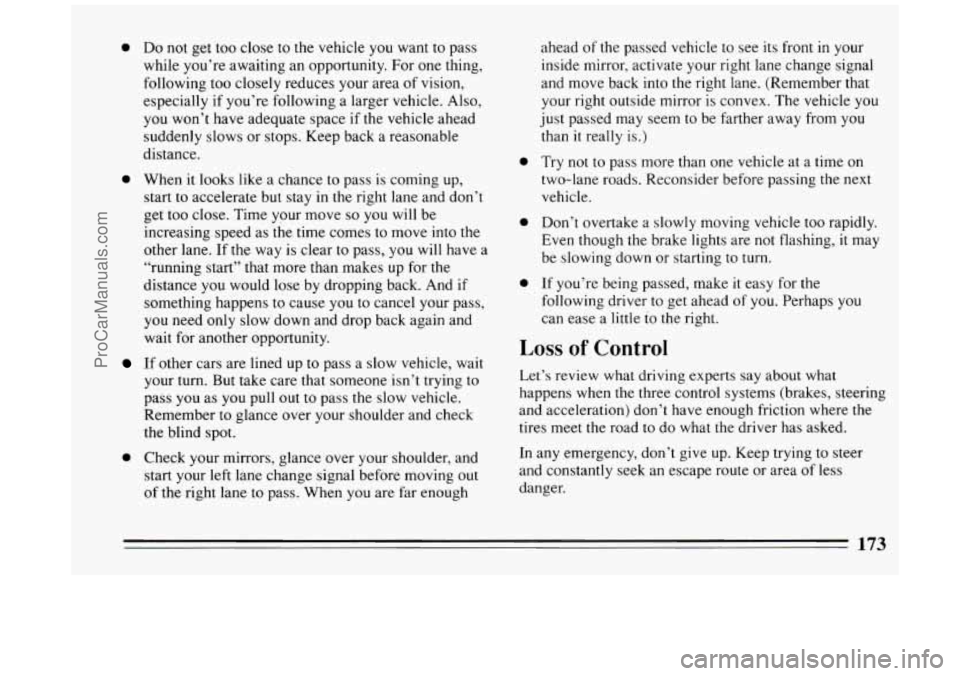
0 Do not get too close to the vehicle you want to pass
while you’re awaiting an opportunity. For one thing,
following too closely reduces your area of vision,
especially if you’re following a larger vehicle. Also,
you won’t have adequate space if the vehicle ahead
suddenly slows or stops. Keep back a reasonable
distance.
0 When it looks like a chance to pass is coming up,
start to accelerate but stay in the right lane and don’t
get too close. Time your move
so you will be
increasing speed as the time comes to move into the
other lane. If the way is clear to pass, you will have a
“running start” that more than makes up for the
distance you would lose by dropping back. And if
something happens to cause you to cancel your pass,
you need only slow down and drop back again and
wait for another opportunity.
If other cars are lined up to pass a slow vehicle, wait
your turn. But take care that someone isn’t trying to
pass you as you pull out
to pass the slow vehicle.
Remember
to glance ov’er your shoulder and check
the blind spot.
0
0
0
ahead of the passed vehicle to see its front in your
inside mirror, activate your right lane change signal
and move back into the right lane. (Remember that
your right outside mirror
is convex. The vehicle you
just passed may seem to be farther away from you
than
it really is.)
Try not to pass more man one vehicle at a time on
two-lane roads. Reconsider before passing the next
vehicle.
Don’t overtake
a slowly moving vehicle too rapidly.
Even though the brake lights are not flashing,
it may
be slowing down or starting to
turn.
If you’re being passed, make it easy for the
following driver to get ahead
of you. Perhaps you
can ease a little
to the right.
Loss of Control
Let’s review what driving experts say about what
happens when the three control systems (brakes, steering
and acceleration) don’t have enough friction where the
tires meet the road to do what the driver has asked.
0 Check your mirrors, glance over your shoulder, and
start your left lane change signal before moving out
of the right lane to pass. When you are far enough In
any emergency, don’t give up. Keep trying to steer
and constantly seek an escape route or area of less
danger.
173
ProCarManuals.com
Page 176 of 324
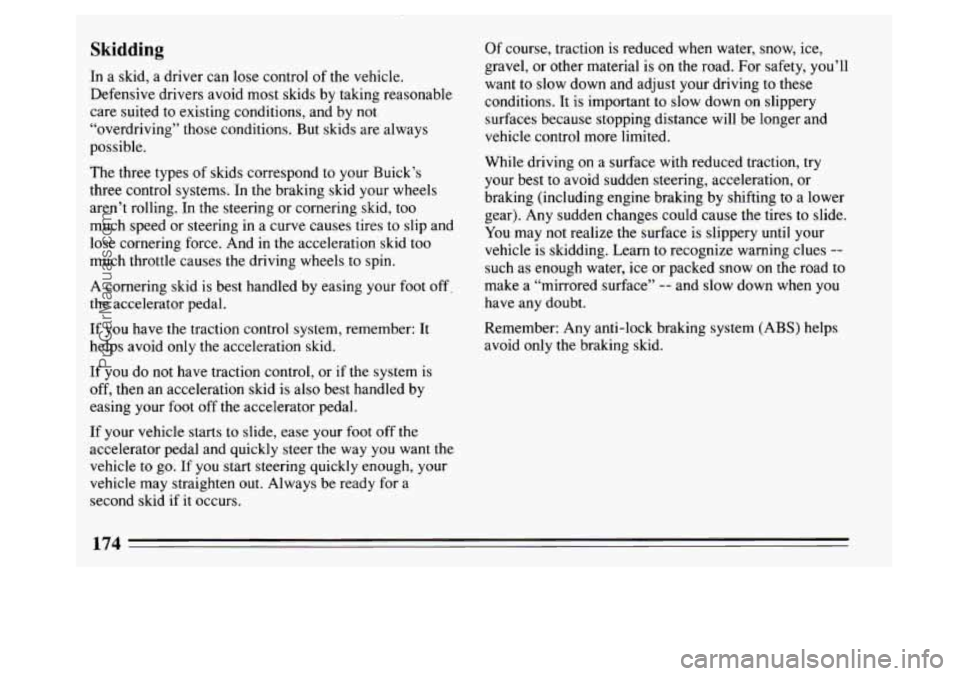
Skidding
In a skid, a driver can lose control of the vehicle.
Defensive drivers avoid most skids by taking reasonable
care suited to existing conditions, and by not
“overdriving” those conditions. But skids are always
possible.
The three types
of skids correspond to your Buick’s
three control systems. In the braking skid your wheels
aren’t rolling. In the steering or cornering skid, too
much speed or steering in a curve causes tires
to slip and
lose cornering force. And in the acceleration skid too
much throttle causes the driving wheels to spin.
A cornering skid is best handled by easing your foot off”
the accelerator pedal.
If you have the traction control system, remember: It
helps avoid only the acceleration skid.
If you do not have traction control, or if the system is
off, then an acceleration skid is also best handled by
easing your foot off the accelerator pedal.
If your vehicle starts
to slide, ease your foot off the
accelerator pedal and quickly steer the way you want the
vehicle
to go. If you start steering quickly enough, your
vehicle may straighten out. Always be ready for a
second skid if it occurs. Of
course, traction is reduced when water, snow, ice,
gravel, or other material is on the road. For safety, you’ll
want to slow down and adjust your driving
to these
conditions. It is important to slow down on slippery
surfaces because stopping distance will be longer and
vehicle control more limited.
While driving
on a surface with reduced traction, try
your best to avoid sudden steering, acceleration, or
braking (including engine braking by shifting to a lower
gear). Any sudden changes could c’ause the tires to slide.
You may not realize the surface is slippery until
your
vehicle is skidding. Learn to recognize warning clues --
such as enough water, ice or packed snow on the road to
make a “mirrored surface”
-- and slow down when you
have any doubt.
Remember: Any anti-lock braking system
(ABS) helps
avoid only the braking skid.
174
ProCarManuals.com
Page 177 of 324
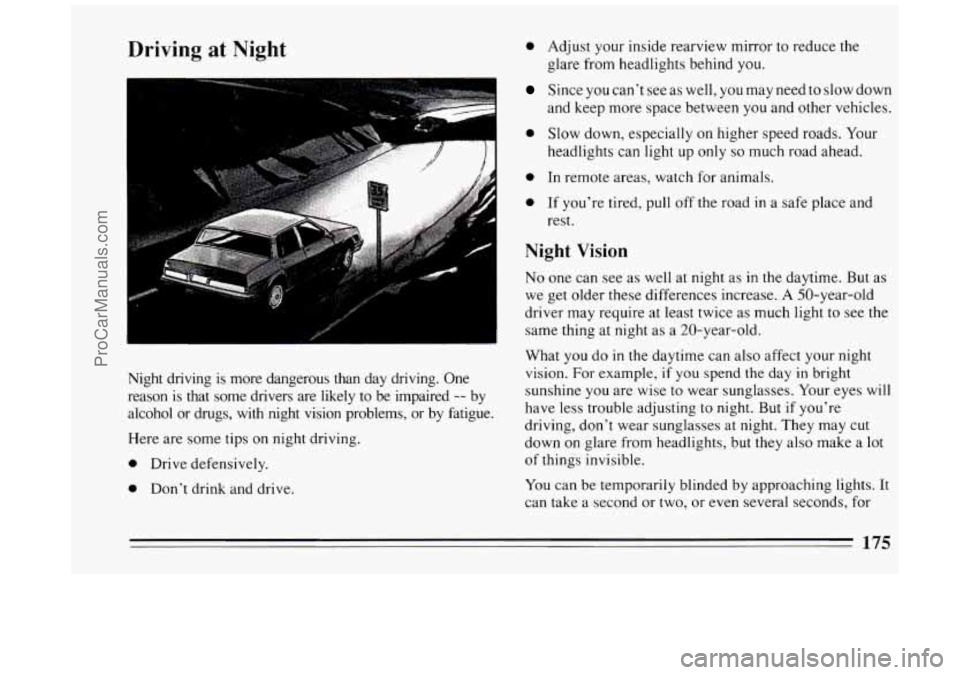
Driving at Night
rn
.. .
0 Adjust your inside rearview mirror to reduce the
glare from headlights behind you.
Since you can’t see as well, you may need to slow down
and keep more space between you and other vehicles.
0 Slow down, especially on higher speed roads. Your
headlights can light up only
so much road ahead.
0 In remote areas, watch for animals.
0 If you’re tired, pull off the road in a safe place and
rest.
Night Vision
Night driving is more dangerous than day driving. One
reason is that some drivers are likely to be impaired
-- by
alcohol or drugs, with night vision problems, or by fatigue.
Here are some tips on night driving.
0 Drive defensively.
0 Don’t drink and drive. No
one can see as well at night as in the daytime. But as
we get older these differences increase. A 50-year-old
driver may require at least twice as much light to see the
I same thing at night as a 20-year-old.
What you do in the daytime can also affect your night
vision. For example,
if you spend the day in bright
sunshine you are wise to wear sunglasses. Your eyes will
have less trouble adjusting to night. But
if you’re
driving, don’t wear sunglasses at night. They may cut
down on glare from headlights, but they also make a lot
of things invisible.
You can be temporarily blinded by approaching lights. It
can take a second or two, or even several seconds, for
175
ProCarManuals.com
Page 182 of 324
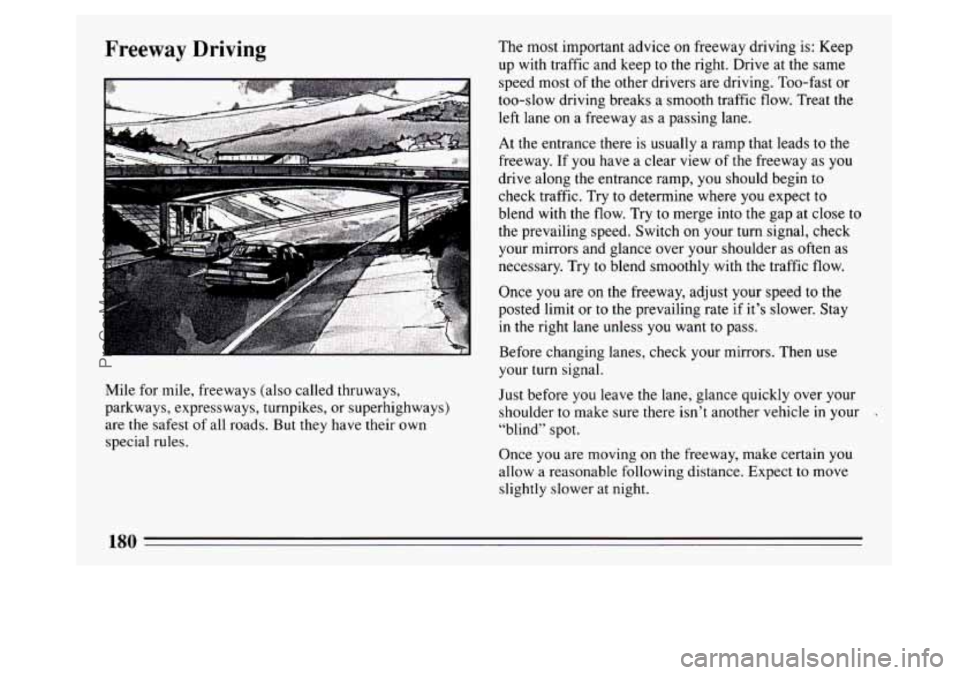
Freeway Driving
I
Mile for mile, freeways (also called thruways,
parkways, expressways, turnpikes, or superhighways)
are the safest
of all roads. But they have their own
special rules. The
most important advice on freeway driving is: Keep
up with traffic and keep to the right. Drive at the same
speed most
of the other drivers are driving. Too-fast or
too-slow driving breaks a smooth traffic flow. Treat the
left lane on a freeway as a passing lane.
At the entrance there is usually a ramp that leads to the
freeway. If you have a clear view
of the freeway as you
drive along the entrance ramp, you should begin to
check traffic. Try to determine where you expect
to
blend with the flow. Try to merge into the gap at close to
the prevailing speed. Switch on your turn signal, check
your mirrors and glance over your shoulder as often as
necessary. Try to blend smoothly with the traffic flow.
Once you are on the freeway, adjust your speed to the
posted limit or to the prevailing rate if it’s slower. Stay
in the right lane unless you want to pass.
Before changing lanes, check your mirrors. Then use
your turn signal.
Just before you leave the lane, glance quickly over your
shoulder to make sure there isn’t another vehicle in your
“blind” spot.
Once you are moving on the freeway, make certain you
allow a reasonable following distance. Expect to move
slightly slower at night.
on
ProCarManuals.com
Page 184 of 324
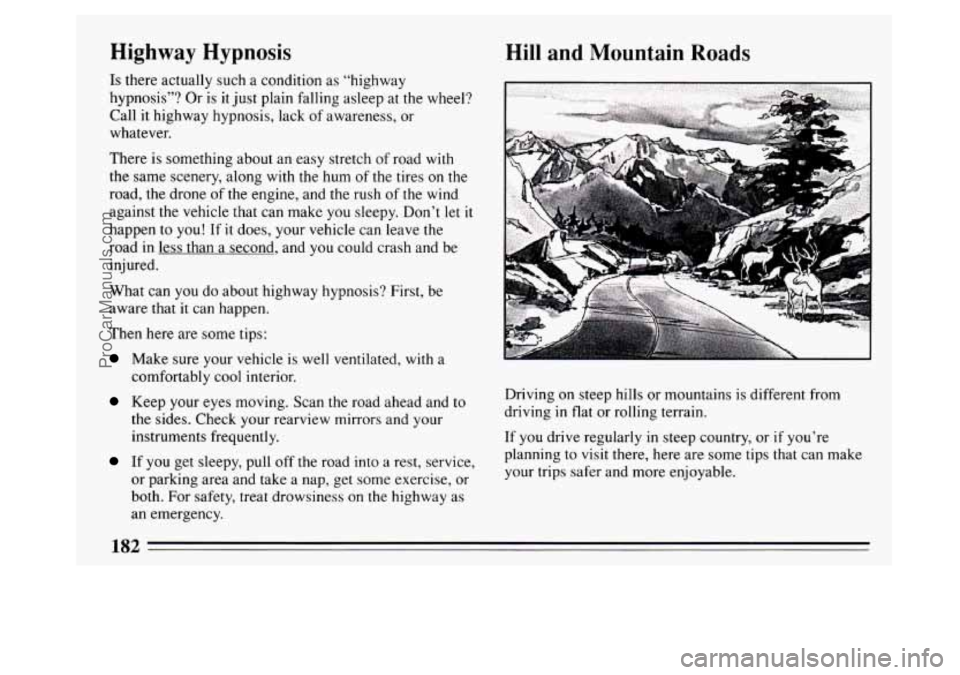
Highway Hypnosis
Is there actually such a condition as “highway
hypnosis”? Or is it just plain falling asleep at the wheel?
Call
it highway hypnosis, lack of awareness, or
whatever.
There is something about an easy stretch
of road with
the same scenery, along with
the hum of the tires on the
road, the drone of the engine, and the rush of the wind
against the vehicle that can make you sleepy. Don’t let
it
happen to you! If it does, your vehicle can leave the
road
in less than a second, and you could crash and be
inj ured.
What can you do about highway hypnosis? First, be
aware that it can happen.
Then here are some tips:
Make sure your vehicle is well ventilated, with a
comfortably cool interior.
Keep your eyes moving. Scan the road ahead and to
the sides. Check your rearview mirrors and your
instruments frequently.
If you get sleepy, pull off the road into a rest, service,
or parking area and take a nap, get some exercise, or
both. For safety, treat drowsiness on the highway as
an emergency.
Hill and Mountain Roads
Driving on steep hills or mountains is different from
driving in flat or rolling terrain.
If
you drive regularly in steep country, or if you’re
planning
to visit there, here are some tips that can make
your trips safer and more enjoyable.
182
ProCarManuals.com
Page 194 of 324
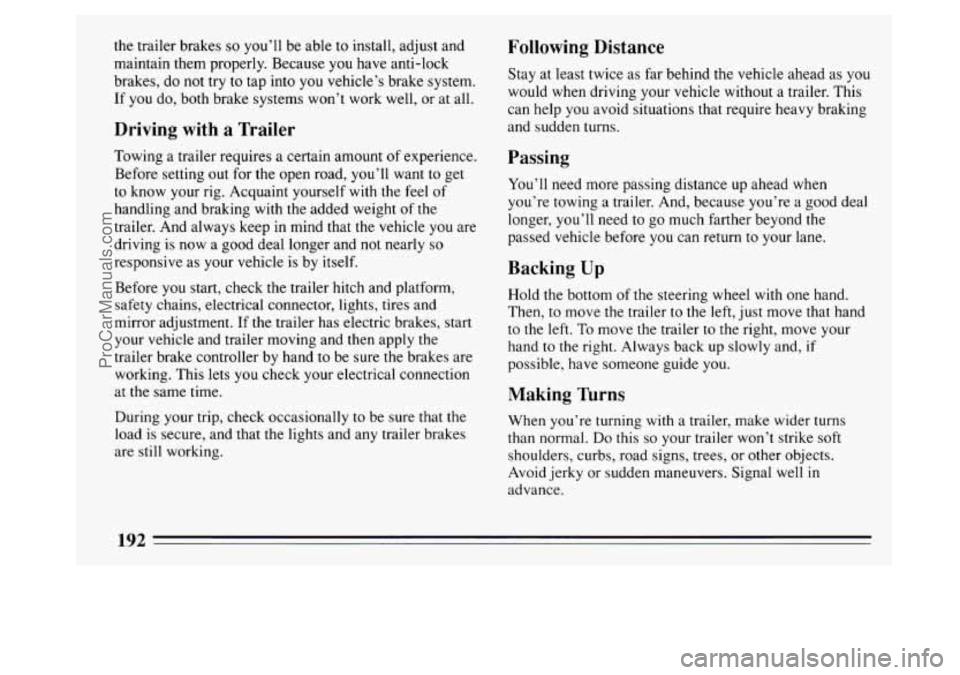
the trailer brakes so you’ll be able to install, adjust and
maintain them properly. Because you have anti-lock
brakes, do not try
to tap into you vehicle’s brake system.
If
you do, both brake systems won’t work well, or at all.
Driving with a Trailer
Towing a trailer requires a certain amount of experience.
Before setting out for the open road, you’ll want to get
to know your rig. Acquaint yourself with the feel of
handling and braking with the added weight of the
trailer. And always keep in mind that the vehicle you are
driving is now a good deal longer and not nearly
so
responsive as your vehicle is by itself.
Before you start, check the trailer hitch and platform,
safety chains, electrical connector, lights, tires and
mirror adjustment. If the trailer has electric brakes, start
your vehicle and trailer moving and then apply the
trailer brake controller by hand to be sure the brakes are
working. This lets you check your electrical connection
at the same time.
During your trip, check occasionally to be sure that the
load is secure, and that the lights and any trailer brakes
are still working.
Following Distance
Stay at least twice as far behind the vehicle ahead as you
would when driving your vehicle without a trailer. This
can help you avoid situations that require heavy braking
and sudden turns.
Passing
You’ll need more passing distance up ahead when
you’re towing a trailer. And, because you’re a good deal
longer, you’ll need
to go much farther beyond the
passed vehicle before you can return to your lane.
Backing Up
Hold the bottom of the steering wheel with one hand.
Then, to move the trailer to the
left, just move that hand
to the left.
To move the trailer to the right, move your
hand to the right. Always back up slowly and,
if
possible, have someone guide you.
Making Turns
When you’re turning with a trailer, make wider turns
than normal.
Do this so your trailer won’t strike soft
shoulders, curbs, road signs, trees, or other objects.
Avoid jerky or sudden maneuvers. Signal well in
advance.
192
ProCarManuals.com
Page 281 of 324
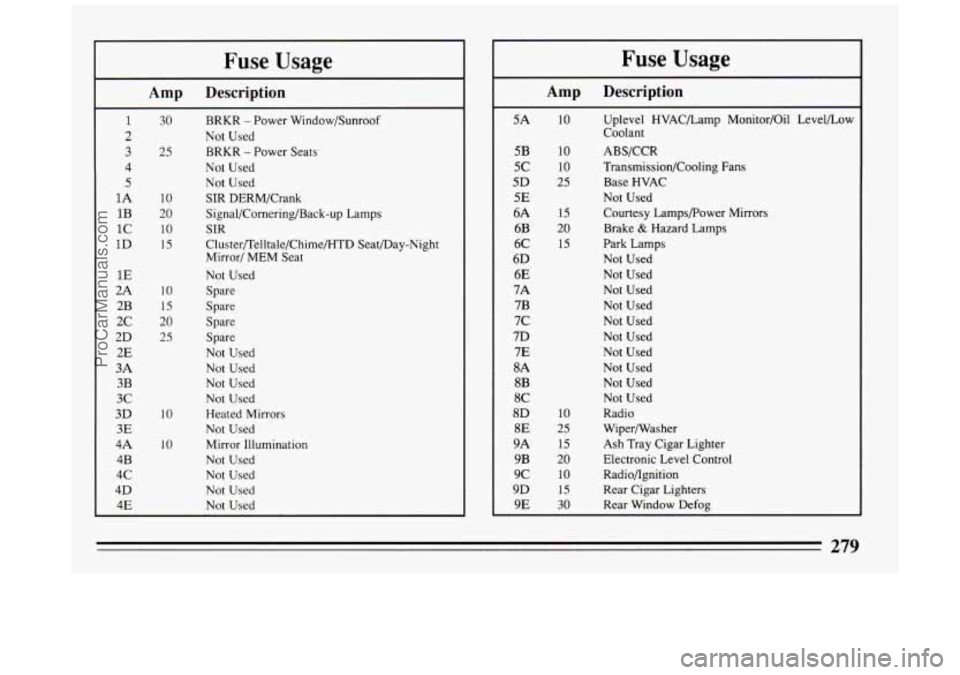
Fuse Usage
Amp Description
1
2
3
4
5
1A
1B
1c
1D
1E
2A
2B
2c
2D 2E
3A 3B
3c
3D 3E
4A 4B
4c
4D
4E
10
20
10
30 BRKR - Power Window/Sunroof
25 BRKR
- Power Seats
Not Used
Not Used
Not Used
SIR DERM/Crank
Signal/Cornering/Back-up Lamps
SIR
15
10
15
20
25
10
10
:ht Cluster/Telltale/Chime/HTD Seat/Day-Nig
Mirror/ MEM Seat
Not Used
Spare
Spare
Spare
Spare
Not Used
Not Used
Not Used
Not Used
Heated Mirrors
Not Used
Mirror Illumination
Not Used
Not Used
Not Used
Not Used
Amp Description
5A
5B
5c
5D 5E
6A
6B
6C
6D
6E
7A
7B
7c
7D
7E
8A 8B
8C
8D
8E
9A
9B
9c
9D
9E
10
10
10
25
15
20
15
10
25
15
20
10
15
30
Uplevel HVAC/Lamp Monitor/Oil Level/Low
Coolant
ABS/CCR
Transmission/Cooling Fans
Base HVAC
Not Used
Courtesy Lamps/Power Mirrors
Brake
& Hazard Lamps
Park Lamps
Not Used
Not Used
Not Used Not Used
Not Used
Not Used Not Used
Not Used
Not Used
Not Used Radio
Wipermasher
Ash Tray Cigar Lighter
Electronic Level Control
Radiohgnition
Rear Cigar Lighters
Rear Window Defog
279
ProCarManuals.com
Page 283 of 324
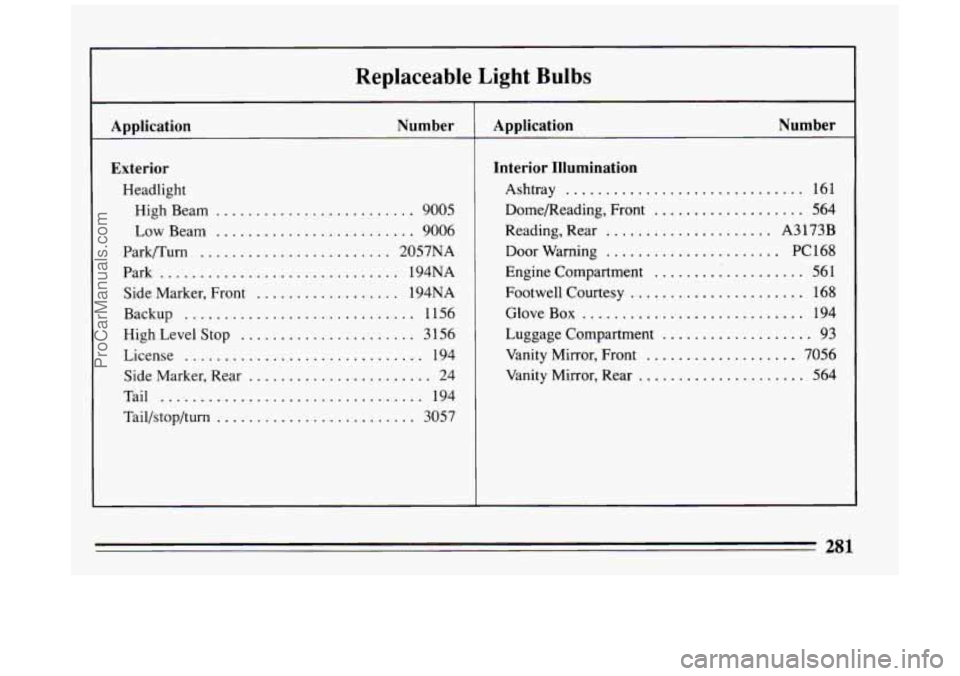
Replaceable Light Bulbs
Application Number
Exterior
Headlight High Beam
......................... 9005
Low Beam ......................... 9006
Park/Turn
........................ 2057NA
Park
.............................. 194NA
Side Marker. Front
.................. 194NA
Backup
............................. 1156
High Level Stop
...................... 3 156
License
.............................. 194
Side Marker. Rear
....................... 24
Tail
................................. 194
Tail/stop/turn
......................... 3057
Application
Interior Illumination
Ashtray .............................. 161
Domemeading. Front
................... 564
Reading. Rear
..................... A3173B
Door Warning
...................... PC168
Engine Compartment
................... 561
Footwell Courtesy ...................... 168
GloveBox
............................ 194
Luggage Compartment
................... 93
Vanity Mirror. Front ................... 7056
Vanity Mirror. Rear ..................... 564
281
ProCarManuals.com